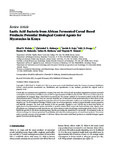Lactic Acid Bacteria from African Fermented Cereal-Based Products: Potential Biological Control Agents for Mycotoxins in Kenya

View/
Date
2022Author
Wafula, Eliud N.
Muhonja, Christabel N.
Kuja, Josiah O.
Owaga, Eddy E.
Makonde, Huxley M.
Mathara, Julius M.
Kimani, Virginia W.
Metadata
Show full item recordAbstract
Cereals play an important role in global food security. Data from the UN Food and Agriculture Organization projects increased
consumption of cereals from 2.6 billion tonnes in 2017 to approximately 2.9 billion tonnes by 2027. However, cereals are prone to
contamination by toxigenic fungi, which lead to mycotoxicosis. +e current methods for mycotoxin control involve the use of
chemical preservatives. However, there are concerns about the use of chemicals in food preservation due to their effects on the
health, nutritional quality, and organoleptic properties of food. +erefore, alternative methods are needed that are affordable and
simple to use. +e fermentation technique is based on the use of microorganisms mainly to impart desirable sensory properties
and shelf-life extension. +e lactic acid bacteria (LAB) are generally regarded as safe (GRAS) due to their long history of
application in food fermentation systems and ability to produce antimicrobial compounds (hydroxyl fatty acids, organic acids,
phenyllactic acid, hydrogen peroxide, bacteriocins, and carbon dioxide) with a broad range of antifungal activity. Hence, LAB can
inhibit the growth of mycotoxin-producing fungi, thereby preventing the production of mycotoxins. Fermentation is also an
efficient technique for improving nutrient bioavailability and other functional properties of cereal-based products. +is review
seeks to provide evidence of the potential of LAB from African fermented cereal-based products as potential biological agents
against mycotoxin-producing fungi.
